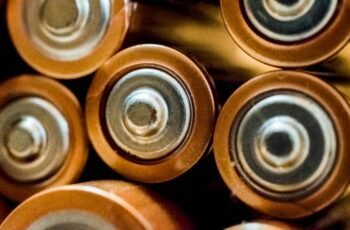Choosing a 12V 100Ah LiFePO4 battery in 2025 isn’t just about capacity—it’s about durability, safety, and smart features that actually help off-grid and RV life. We’ve focused on models with robust BMS protection, clear monitoring, reliable charging profiles, and real-world support. We’ll cover a compact Group 24 with a display, a rugged Group 31 with a 100A BMS, and a value 2-pack. Here’s what sets them apart—and why it matters.
Key Takeaways
- Choose true drop‑in Group 24/31 12V 100Ah LiFePO4 packs with ~1280Wh, 100A BMS, and IP67 or robust housings for off‑grid/RV durability.
- Prioritize smart BMS protections (over/under‑voltage, over‑current, short‑circuit, temp, low‑temp cutoff) with auto‑recovery for safe, unattended operation.
- Look for expandable 4S/4P capability; balance each pack (≈10V per unit for series) before linking to build 24–51.2V or higher‑Ah banks.
- Expect flat voltage delivery, 100A continuous (200A burst), 14.4–14.6V charging, and 4,000–15,000 cycles depending on depth of discharge.
- Favor lightweight packs (18–24 lb) with onboard meters for easy monitoring, CE‑certified cells, 5‑year support, and solar/alternator charger compatibility.
12V 100Ah LiFePO4 Battery with Display (Group 24, 1280Wh)
November 20, 2025 2:02 am
If you want a compact, lightweight drop‑in that still packs real off‑grid muscle, this 12V 100Ah LiFePO4 Battery with Display (Group 24, 1280Wh) is our pick for RVers, boaters, and solar users who value reliable power without the bulk. At 20 pounds, it replaces lead‑acid at roughly 70% less weight, yet delivers 1280Wh from Grade‑A cells. The IP67 housing and 100A BMS handle dust, moisture, and temperature extremes. We like the onboard meter for voltage and capacity. It’s 4P4S capable for series/parallel builds; set each unit to 10V before linking. Installation’s simple—M8 hardware included, no rewiring needed. Reviews average 4.6/5.
Best For: RVers, boaters, and off‑grid/solar users who need a compact, lightweight Group 24 drop‑in battery with reliable 12V power and a built‑in display.
Pros:
- Lightweight 20 lb design replaces lead‑acid at ~70% less weight while delivering 1280Wh from Grade‑A LiFePO4 cells
- Built‑in 100A BMS with IP67 housing for robust protection (over/under voltage, overcurrent, temp, dust/moisture)
- Easy drop‑in install with M8 hardware and onboard voltage/capacity meter; supports 4P4S series/parallel expansion
Cons:
- Requires setting each battery to 10V before series linking, adding a setup step
- 100A BMS may limit very high surge loads compared to larger-capacity BMS units
- Warranty details not fully specified beyond Amazon return policy
12V 100Ah LiFePO4 Lithium Battery with Built-in 100A BMS (Group 31)
November 19, 2025 11:04 pm
Looking for a true drop-in Group 31 that’s light, safe, and expandable? We like this 12V 100Ah LiFePO4 with a built-in 100A Smart BMS. It fits BCI Group 31 boxes, weighs about 18–24 lb, and stores 1280Wh. The BMS shields against overcharge, over-discharge, over-current, overheating, and short circuits, plus low-temp protection.
Charge it three ways: a 14.6V 20A charger in about five hours, solar with a controller, or an alternator. Expect flat voltage delivery, low self-discharge, and 4000–15000 cycles depending on depth of discharge. Wire up to 4S or 4P for 48V or 400Ah. We appreciate the 5-year after-service support and 24-hour response.
Best For: RVers, boaters, and off-grid users who want a lightweight, Group 31 drop-in LiFePO4 battery with strong BMS protection and easy series/parallel expansion.
Pros:
- Lightweight Group 31 form factor (approx. 18–24 lb) with 1280Wh and flat voltage delivery
- Built-in 100A Smart BMS with low-temperature, over/under-voltage, over-current, overheating, and short-circuit protection
- Long lifespan (4000–15000 cycles by DOD), supports 4S/4P expansion, and multiple charging methods (14.6V charger, solar, alternator)
Cons:
- Real-world tested capacity reported slightly below nominal in some reviews (around 1256–1267Wh at C/20)
- Charging requires LiFePO4-compatible profile (14.6V), which may need charger/controller upgrades
- Conflicting weight specs and occasional terminal/bolt considerations noted by users
12V 100Ah LiFePO4 Lithium Battery (2 Pack)
November 20, 2025 2:02 am
Serious RVers and off‑grid users will like this 12V 100Ah LiFePO4 (2‑pack) for its lightweight build and solid 100A BMS that delivers steady 12.8V power. We get 1280Wh per battery in a 12.9 x 6.7 x 8.5‑inch case at about 23.1 lb; charge at 14.4V. Scale 4S4P to 51.2V/20.48kWh.
Durability/cycles: up to 15,000 cycles, about 10‑year service, 33% lighter than lead‑acid. Continuous 100A, 200A for 3 seconds.
Protection: CE cells, LiFePO4 safety, temp window −4°F to 140°F, auto low‑temp cutoff, full BMS faults with 1‑second auto‑reset.
Uses: RV, marine, trolling, solar, UPS, backup.
Notes: 4.3/5; easy setup; occasional weight and connection variance.
Best For: RVers, boaters, and off‑grid users needing lightweight 12V power with scalable capacity and a robust 100A BMS.
Pros:
- 12.8V nominal, 100Ah (1280Wh) per battery; 2‑pack scales to 4S4P (51.2V/20.48kWh)
- 100A continuous discharge (200A 3s), CE‑certified LiFePO4 with full BMS protections and 1‑second auto‑reset
- Lightweight (~23.1 lb), long life (up to 15,000 cycles, ~10 years), wide temp range with low‑temp cutoff
Cons:
- Reported weight and connection capability variance by batch
- Requires correct LiFePO4 charging (14.4V); may not suit chargers set for lead‑acid profiles
- 30‑day voluntary return; warranty terms depend on Amazon policies
Factors to Consider When Choosing LiFePO4 12V 100Ah Batteries
Before we pick a 12V 100Ah LiFePO4 battery, we should weigh chemistry quality and verify true usable capacity, not just the label. Let’s compare cycle life ratings and the BMS protection features that guard against over/under-voltage, overcurrent, short circuit, and low-temp charging. We’ll also check the temperature performance range to ensure reliable charging and discharging in our climate.
Battery Chemistry Quality
While capacity and price grab attention, the real foundation of a dependable 12V 100Ah pack is its LiFePO4 chemistry quality. We look for pure-chemistry, automotive-grade cells because they deliver consistent performance, strong cycle life, and higher thermal stability than many lithium-ion variants, cutting the risk of thermal runaway.
Top cells paired with a well-matched BMS can safely support deep discharges and protect against abuse, helping minimize capacity fade over thousands of cycles. Expect 4,000–15,000 cycles depending on depth of discharge and operating habits. We also value low self-discharge, which preserves stored energy during downtime, and robust low-/high-temperature protection that keeps performance predictable in tough climates.
Finally, documented quality control and CE certification signal adherence to recognized safety and performance standards we can trust.
True Usable Capacity
Great cells and a smart BMS set the stage, but what we can actually use comes down to true capacity in real conditions. A 12V 100Ah LiFePO4 typically yields about 1250–1280 Wh when new, yet usable energy is often slightly lower because voltage sags under load. Our discharge depth matters: 100% DoD gives maximum immediate capacity, while running 60–80% DoD offers practical energy with better longevity. C-rate also trims usable Wh—higher discharge currents cut effective output and trigger earlier low-voltage cutoffs.
Temperature is another lever. In the cold, capacity shrinks and low-temp protection may limit charging or discharging. Finally, aging reduces usable capacity over time. Plan systems assuming modest losses, realistic DoD, expected C-rates, and operating temperatures for dependable runtime.
Cycle Life Rating
How long will a 12V 100Ah LiFePO4 actually last in daily use? Let’s look at the cycle life rating. Manufacturers specify cycles at a given depth of discharge (DOD). You’ll see ranges from about 4,000 cycles at 100% DOD to roughly 15,000 cycles at 60% DOD. Put simply, shallower discharges yield more usable cycles.
To compare batteries, we focus on cycle count at the same DOD, ideally 80% or 100%. LiFePO4 chemistry already outperforms lead-acid, often delivering 2–4x more cycles under similar use. With moderate DOD and proper charging, we can expect close to a decade of service in many off-grid and RV setups.
Real-world results depend on usage patterns and temperature. Prioritize credible, independently verified cycle-life data and clear DOD test conditions.
BMS Protection Features
A robust battery management system (BMS) is non-negotiable when we’re choosing a 12V 100Ah LiFePO4. It’s the brain and guardian, preventing overcharge, over‑discharge, over‑current, overheating, and short circuits that can shorten life or trigger shutdowns. We also look for a 100A continuous discharge rating with higher momentary peaks—often up to 200A for a few seconds—to handle inverter start-ups and motor surges without tripping.
Good BMSs cut output during fault conditions, then automatically reactivate once the issue clears, so we don’t need manual resets. That safe recovery matters in remote setups. We also value designs that support series or parallel expansion while maintaining cell balancing and protection per pack; that keeps each battery healthy as we scale capacity or voltage. Finally, built-in low-temp protection adds crucial safety.
Temperature Performance Range
Since the BMS is our safeguard, we also need to know how it handles heat and cold. Most 12V 100Ah LiFePO4 batteries publish clear temperature windows. Smart BMS designs typically protect charging below about -4°F to 32°F (-20°C to 0°C), and many add automatic low‑temperature cutoffs that pause charging or discharging to preserve cell health. On the high end, some units remain usable up to around 140°F (60°C), depending on cell quality and BMS tuning.
We should also expect temperature to affect performance. In colder weather, effective capacity drops and charging slows, even when the BMS allows operation. Planning matters: confirm the battery’s charging and operating limits, note whether it includes heated options or low‑temp charging protection, and consider where we’ll mount it to mitigate extreme ambient conditions.
Charge/Discharge Rates
What actually matters with charge and discharge rates is matching the battery’s limits to our loads and charging sources. Most 12V 100Ah LiFePO4 packs deliver about 100A continuous with up to 200A short bursts, so they’ll handle inverter surges, motor starts, and heavy appliances if we size them correctly. On charging, aim for 14.4–14.6V; a typical 20A charger returns a full charge in roughly five hours, while solar or an alternator can top up along the way.
We should also balance speed with longevity. Depth of Discharge dictates cycle life: around 4,000 cycles at 100% DOD, ~6,000 at 80%, and up to ~15,000 at 60%. A robust BMS safeguards overcharge, over-discharge, over-current, shorts, and temperature, and it can auto-recover after a fault.
Size and Weight
Power means little if the battery won’t fit or adds too much heft to our rig. LiFePO4 12V 100Ah packs typically weigh 18–24 pounds—far lighter than comparable lead-acid—so we can shed weight and improve handling. Their compact footprint, about 12.9 x 6.6–6.7 inches with roughly 8.5 inches of height, makes placement in tight compartments straightforward.
We also consider energy per footprint. A 100Ah LiFePO4 stores about 1,280Wh at 12V, so we know how long our loads can run before a recharge. The common dimensions align well with Group 24 and Group 31 trays, often requiring minimal mounting tweaks, which speeds swaps and keeps wiring clean. When comparing candidates, we favor consistent dimensions and weights across models to streamline layout, mounting, and transport.
Series/Parallel Expandability
How far do we need to scale—more voltage, more capacity, or both? Many 12V 100Ah LiFePO4 batteries allow series/parallel expansion, often up to 4S or 4P. Series increases voltage (to 24V, 36V, or 51.2V in 4S); parallel boosts capacity (up to 400Ah in 4P) while keeping 12V. Some packs support 4P4S arrays, delivering about 51.2V and 400Ah—roughly 20,480Wh.
Before wiring in series, we balance each battery to the same state of charge and equal terminal voltage to avoid overcurrent during charge/discharge. In parallel, we confirm the BMS supports current sharing and parallel awareness. Across larger arrays, matched cells and robust BMS protection are nonnegotiable to prevent overcharge, overdischarge, and thermal issues. Verify the manufacturer’s exact series/parallel limits and wiring requirements.
Conclusion
We’ve covered three standout 12V 100Ah LiFePO4 batteries for 2025 that balance reliability, capacity, and smart features. Whether you want a Group 24 with a handy display, a rugged Group 31 with a 100A BMS and IP67 protection, or a value-packed 2-pack, you’ll get around 1,280Wh, long cycle life, and flexible expansion. Prioritize 14.4–14.6V charging compatibility, auto-recovery safety, and strong support. Choose confidently, and enjoy dependable, lightweight power for off-grid adventures and RV life.





